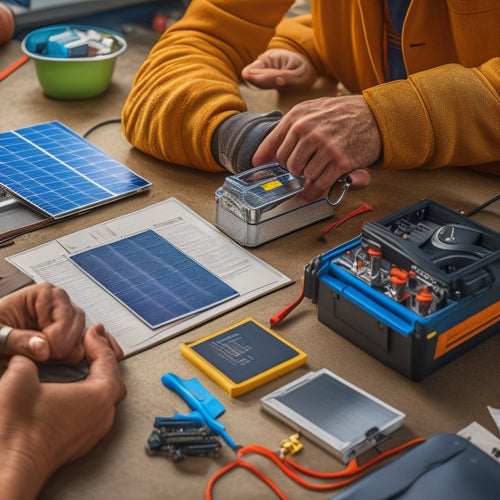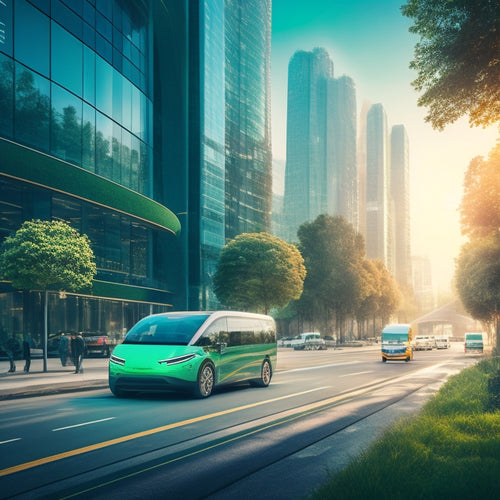
Charge Your Ride With Renewable Energy Solutions
Share
By immersing yourself in renewable energy sources like solar power, you can greatly diminish your carbon footprint and reliance on fossil fuels, with solar panels capable of generating enough electricity to fuel your electric vehicle and even power your home. As you charge your ride with renewable energy solutions, you'll not only contribute to a sustainable future but also enjoy lower operating costs. Explore how to harness solar power, design efficient charging stations, and plan eco-friendly routes to maximize your electric vehicle's potential. Plunge into the world of sustainable transportation and discover a wealth of innovative solutions awaiting your exploration.
Key Takeaways
• Harness solar power to generate electricity and reduce your carbon footprint with solar panels installed at home or at solar farms.
• Plan eco-friendly road trips by identifying green pitstops with renewable energy refueling, solar-powered charging stations, and wind-powered stations.
• Design efficient charging stations with well-planned architecture, minimizing congestion, and strategically placed charging points for easy navigation.
• Maintain your EV's battery health by monitoring charging habits, avoiding extreme temperatures, and charging between 20% and 80% to reduce wear and tear.
• Explore solar panel installation options, including roof-mounted and ground-mounted arrays, to optimize energy production and enhance your property's curb appeal.
Harnessing Solar Power for EVs
As you consider powering your electric vehicle (EV) with renewable energy, harnessing solar power emerges as a clean, efficient, and increasingly viable solution, allowing you to tap into the abundant energy of the sun to fuel your ride.
By investing in solar panels, you can generate electricity and charge your EV, reducing your carbon footprint and reliance on fossil fuels.
Solar farms are large-scale solar power installations that can provide a significant amount of electricity, making them an attractive option for EV owners. When combined with energy storage systems, you can store excess energy generated during the day for use during periods of low sunlight or at night, ensuring a steady power supply for your EV.
This setup enables you to maximize your solar energy production and reduce your reliance on the grid. With the cost of solar panels decreasing over the years, harnessing solar power is becoming an increasingly accessible and cost-effective solution for EV owners.
Efficient Charging Station Design
When designing an efficient charging station for your EV, you'll want to explore a layout that minimizes congestion, reduces wait times, and optimizes the flow of traffic. A well-planned station architecture is essential to achieve this goal.
Explore a layout that allows for easy navigation, adequate parking spaces, and strategically placed charging points. This will enable a smooth flow of traffic and reduce congestion.
Cable management is another vital aspect to explore. A well-organized cable management system guarantees that cables are safely stored, reducing tripping hazards and minimizing the risk of damage. It also helps to keep the station clean and organized, enhancing the overall user experience.
Renewable Energy for Road Trips
You'll need to plan ahead to make sure you're fueled by renewable energy on your road trip, especially since EV charging infrastructure can be limited in rural areas. To guarantee a seamless journey, research Eco friendly Routes that align with your travel plans. This will help you identify Green Pitstops along the way, where you can recharge your vehicle and take a break.
| Renewable Energy Solution | Benefits |
|---|---|
| Solar-powered charging stations | Reduces carbon footprint, generates clean energy |
| Wind-powered charging stations | Harnesses wind energy, minimizes reliance on fossil fuels |
| Hydrogen fuel cell stations | Zero-emission fuel source, reduces greenhouse gases |
Sustainable Battery Maintenance Tips
Properly caring for your electric vehicle's battery is vital to ensuring a long lifespan and peak performance. You've invested in a sustainable ride, and now it's time to keep your battery in top shape.
To maintain peak Battery Health, it's important to monitor your charging habits. Avoid extreme temperatures, as they can affect your battery's performance and lifespan. When possible, charge your vehicle when the battery is between 20% and 80% full, as this helps reduce wear and tear.
Cell Balancing is another critical aspect of sustainable battery maintenance. This process ensures that each cell in your battery is charged and discharged evenly, preventing any single cell from dominating the others. You can use a battery management system or a smart charger to monitor and balance your cells.
Solar Panel Installation Options
When it comes to harnessing the sun's energy for your ride, you have two primary options for solar panel installation: roof-mounted solar panels or ground-mounted solar arrays.
You'll want to take into account factors like available space, energy output, and aesthetic appeal when deciding between these two approaches.
Roof-Mounted Solar Panels
By integrating roof-mounted solar panels into your vehicle's design, you can harness the sun's energy to power your ride's electrical systems. This installation option offers a sleek and streamlined look, blending seamlessly with your vehicle's roof. When it comes to roof aesthetics, you'll appreciate the modern and futuristic appeal of roof-mounted solar panels.
The sleek, low-profile design guarantees a seamless integration with your vehicle's existing architecture.
From an energy efficiency perspective, roof-mounted solar panels provide an excellent solution. By maximizing the surface area of your vehicle's roof, you can generate a substantial amount of clean energy. This, in turn, reduces your reliance on traditional fuel sources and minimizes your carbon footprint.
With roof-mounted solar panels, you can enjoy the benefits of renewable energy while maintaining a stylish and modern appearance. By choosing this installation option, you'll not only reduce your environmental impact but also elevate your vehicle's overall design and functionality.
Ground-Mounted Solar Arrays
In addition to ground-mounted solar arrays offer a versatile and efficient solar panel installation option, allowing you to harness the sun's energy from a fixed location, rather than relying on your vehicle's roof space. This setup enables you to optimize energy production by strategically positioning the panels to maximize sunlight exposure.
With ground-mounted solar arrays, you can choose the ideal location for your solar panels, taking into account factors like shading, orientation, and solar irradiance. This flexibility also allows for creative solar landscaping, seamlessly integrating your array into your outdoor space.
Furthermore, you can customize the array's aesthetics to blend with your surroundings, ensuring a visually appealing installation. By choosing a ground-mounted solar array, you'll benefit from increased energy production, reduced maintenance, and a sleek, modern design that complements your vehicle and outdoor space.
With the right installation, you'll be harnessing renewable energy while enhancing your property's curb appeal.
Charging Station Location Strategies
You'll need to strategically locate charging stations along your daily commute and frequent destinations to guarantee convenient and consistent access to electricity. By doing so, you'll secure that your electric vehicle (EV) is always ready to hit the road.
Urban planning plays a significant role in this process, as it involves identifying high-demand areas such as shopping centers, public parking lots, and transportation hubs. In these locations, charging stations can be easily integrated into existing infrastructure, making it easy for you to charge your EV on-the-go.
In rural areas, accessibility can be a challenge. However, by strategically placing charging stations along highways and in rural towns, you'll be able to extend your EV's range and reduce range anxiety. This approach also encourages the adoption of EVs in rural communities, promoting a cleaner and more sustainable transportation system.
Optimizing Energy Harvesting Systems
As you optimize your electric vehicle's performance, it's equally important to maximize the efficiency of the renewable energy systems that power it. By doing so, you'll secure that your ride is running on clean energy while minimizing its carbon footprint.
To achieve this, focus on optimizing energy harvesting systems, which involves integrating various components to create a seamless and efficient energy flow.
System integration is key to achieving energy efficiency. By connecting your renewable energy sources, such as solar panels or wind turbines, to a centralized energy management system, you can monitor and control energy production and consumption in real-time. This allows you to identify areas of inefficiency and make adjustments to maximize energy harvesting.
Additionally, implementing energy storage solutions, like batteries, can help stabilize the energy supply and reduce energy waste. By optimizing your energy harvesting systems, you'll be able to charge your ride with renewable energy while minimizing your environmental impact.
Future of Green Transportation Infrastructure
As you explore the future of green transportation infrastructure, you'll notice a significant focus on expanding electric highway networks, allowing you to charge your vehicle on the go.
This development is closely tied to the integration of smart grids, which will efficiently manage the increased energy demand.
Electric Highway Expansion
As you navigate the roads, you're likely to notice a significant transformation underway. Governments and private companies are aggressively investing in the development of extensive electric highway networks, slated to revolutionize the future of green transportation infrastructure. This expansion is essential, as it will enable you to charge your electric vehicle (EV) on the go, eliminating range anxiety and making sustainable travel more accessible.
Government incentives are playing an important role in driving this growth. You're benefiting from initiatives like tax credits, rebates, and subsidies that encourage the adoption of EVs and the development of supporting infrastructure. These incentives have sparked a surge in investment, with companies like Electrify America and EVgo leading the charge.
Rural connectivity is another key aspect of electric highway expansion. As you travel through rural areas, you'll notice the emergence of fast-charging corridors, bridging the gap between urban and rural regions. This increased connectivity won't only enhance your travel experience but also foster economic growth in these areas.
As the electric highway network continues to expand, you can expect seamless, sustainable travel to become the new norm.
Smart Grid Integration
You'll rely on smart grid integration to optimize the flow of electricity between the grid and your EV, ensuring that your vehicle is fueled efficiently and sustainably as you travel. This advanced technology enables real-time monitoring and management of energy distribution, allowing for seamless communication between the grid and your electric vehicle.
With smart grid integration, you'll experience:
-
Efficient energy distribution: Optimized energy flow reduces strain on the grid, ensuring a reliable and sustainable charging experience.
-
Predictive maintenance: Advanced Grid Analytics detect potential issues before they occur, minimizing downtime and ensuring your EV is always ready to hit the road.
-
Energy Forecasting: Accurate predictions of energy demand enable utilities to manage energy distribution more efficiently, reducing waste and promoting a more sustainable future.
-
Enhanced safety features: Real-time monitoring and advanced safety protocols protect both you and the grid from potential hazards.
-
Increased grid resilience: Smart grid integration strengthens the overall energy infrastructure, providing a more reliable and efficient charging experience for all EV owners.
Frequently Asked Questions
How Does Weather Impact Solar Panel Energy Output for EV Charging?
Imagine a cloudy umbrella shielding your solar panels - that's what happens on cloudy days, reducing energy output by up to 50%. You'll also notice seasonal fluctuations, with winter months yielding 20-30% less energy, affecting your EV's juice.
Are Renewable Energy Certificates Applicable to EV Charging Stations?
You can apply Renewable Energy Certificates (RECs) to EV charging stations, offsetting emissions with carbon offset credits and earning green badges, demonstrating your commitment to sustainable transportation.
Can I Use Wind Power to Charge My Electric Vehicle at Home?
Like Don Quixote tilting at windmills, you're harnessing the power of the wind to charge your EV at home. Install a small wind turbine, pair it with energy storage and a power inverter, and you'll be spinning your way to a renewable ride.
Do Electric Vehicles Have Higher Maintenance Costs Than Gas-Powered Cars?
You'll find that electric vehicles typically have lower maintenance costs than gas-powered cars, thanks to fewer moving parts and regenerative braking, which reduces wear on tires and increases battery durability.
Can I Sell Excess Energy Generated by My Solar Panels Back to the Grid?
You can sell excess energy generated by your solar panels back to the grid through a grid connection, storing surplus energy in an energy storage system for later use or feeding it back into the grid.
Related Posts
-

7 Essential Tips for DIY Solar Car Battery Install
To guarantee a successful DIY solar car battery installation, you'll need to choose the right components and follow p...
-

What Are the Safety Certification Requirements?
You need to make sure your electric scooter meets rigorous safety certification requirements to guarantee a safe ride...
-

5 Best Online Stores for Green Vehicle Solutions
You're on the hunt for an eco-friendly ride, and online stores are a great place to start. You'll find top retailers ...


